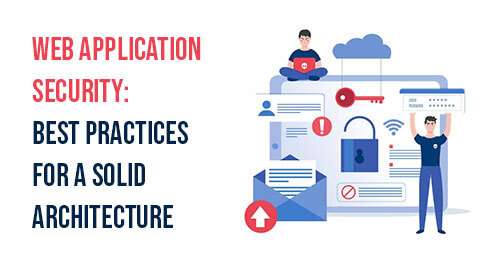
Web Application Security: Best Practices for a Solid Architecture
In a tech-evolving world, it is equally important to strategize the security of web applications! Are you looking for ways to do it? We have got your solution!
A web application is an integral part of every business today and the daily life of commoners. These applications are exposed to many security threats. Hence, you need to ingrain security features in each phase of its SDLC (software development lifecycle) and ensure its safety from threats.
The blog discusses the top 10 best practices for solid web application security architecture. These practices ensure that layers of security are incorporated into your app development and testing processes.
Web Application Security- Top 10 Security Practices For Securing Web Applications
Also known as Web AppSec, it is the practice of building application software with a collection of security controls engineered into it to prevent hackers and malware from manipulating your systems. The aim is to protect it from misdirection or disruption of the services they are designed to provide or any data theft.
Understand the risks that the Application Faces
A crucial step to underlying a secure application starts by analyzing and managing these cyber threats your business software may face. Hire a security team to find potential vulnerabilities in your application. You can also set specific security requirements while designing web applications.
- Find the assets of your application that you should protect: data, hardware, software, and other resources.
- Decide the value of the noted assets to the organization and prioritize them accordingly.
- Find potential threats to your application by hackers, insider threats, and physical security risks and consider their impact on your organization.
- Note vulnerabilities that might happen in software code, network infrastructure, third-party libraries, and user interfaces with their potential impact on your application's security
- Plan and develop mitigation strategies
Establish a Secure Software Development Life Cycle (SDLC)
Once you are cleared with step 1, it is time for development teams to implement secure SDLC. It refers to the planned activities to develop software products while integrating security into the requirement gathering, design, development, testing, and operation/maintenance phases.
- Requirement gathering phase: Define security requirements- data encryption, user authentication, and access control for the application.
- Design and development phase: Reduces the attack surface as much as possible. You should use secure coding practices like obfuscation and minification and follow industry-standard guidelines. Applications should also take special care when using open-source systems.
- Testing phase: Regular application security practices like penetration testing, vulnerability scanning, and code review should be implemented to remediate security flaws.
- Operation/maintenance phase: You should secure server configurations and network protections. Also, keep regularly updating your web application and monitor for security incidents to respond to them promptly. You can use security tools like intrusion detection systems (IDS), security information and event management (SIEM) solutions, and application performance monitoring (APM) tools for it.
Implement Authentication and Access Control Mechanism
Authentication and Access Control Mechanism is a process by which a web application verifies the identity of a user who wants to use it. You can implement this using two primary practices:
- Use Multi-Factor Authentication (MFA): Here, users must pass two or more forms of identification before accessing an application. It can be done using passwords, possession-based tokens, inherence-based biometrics factors, and more.
- Apply the Principle of Least Privilege: Here, software restricts user access to only the minimum necessary resources and permissions of the application. You can also allow role-based access control (RBAC) to ensure appropriate user access levels.
Use Secure Database
Databases require specialized security measures to mitigate risks. You should use real-time security information and event monitoring (SIEM) for database security and protocols like Secure Sockets Layer (SSL) or Transport Layer Security (TLS) for secure data transmission.
Keep Your Application Updated
Regularly monitor vendor websites and security blogs to stay updated about new software vulnerabilities in the market and ways to counter them. You should implement a patch management system to evaluate the software automatically and deploy patches when required. It also helps you upgrade your application with time.
- Security patches to cover the security holes and prevent a hacker or malware from exploiting a way into your network.
- Bug-fix patches to resolve problems in the functionality of the software application.
- Feature update patches give the software application additional capabilities compared to previous versions.
Other practices for secure web application architecture are:
- Prevent SQL injection and cross-site scripting (XSS) attacks by implementing checking for correct data types, length, format, and range.
- Use software frameworks and libraries that have been security-reviewed. You should also make sure to prevent buffer overflows and format string vulnerabilities.
- Ensure that error messages do not reveal sensitive information and log all security-related events for suspicious activities.
- Use secure session management techniques with secure session IDs, enforce session timeouts, and invalidate sessions when users log out.
- You can prevent unauthorized access to data or functionality by implementing a Zero-trust security architecture.
Conclusion
By adopting web application security solutions, businesses can safeguard their data and maintain customer trust. However, one should perform periodic security audits to evaluate the effectiveness of the implemented security practices timely.
Web application security is an ongoing process. You can leave the implementation of the web application security best practices to any trusted web development company. Application security analysts help you significantly reduce security risk and protect your organization's valuable assets by implementing a security-focused culture.





